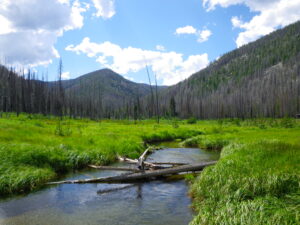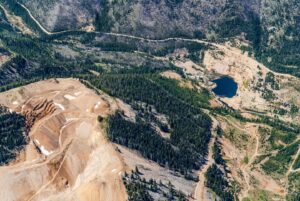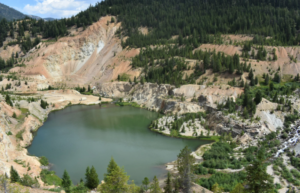The South Fork Salmon River is one of Idaho’s most ecologically important watersheds. The river and its tributaries like the East Fork South Fork provide critical habitat for Chinook salmon, steelhead and bull trout. The surrounding mountains provide important denning habitat for wolverines. Much like a younger, scrappier sibling of the Middle Fork Salmon River, the South Fork also provides world-renowned whitewater recreation opportunities. Sadly, the East Fork South Fork suffers from historic mining pollution with the Stibnite mining area in its headwaters, and the area faces another huge threat with a newly proposed project – the Stibnite Gold Project. Mining company Perpetua Resources is in the advanced stages of permitting a massive open-pit cyanide vat leach mine at the Stibnite site, raising alarm for all that rely on and enjoy this area. In a series of blogs, we investigate the impacts of this project on our beloved public lands, water, fish and wildlife, public health, and recreation opportunities.

Stibnite Gold Project: An alarming history
The Stibnite Gold Project, which is proposed in the headwaters of one of Idaho’s most iconic rivers and just past the town of Yellow Pine, would have detrimental impacts on the land and water in this area.
In October 2022, the Forest Service released the Supplemental Draft Environmental Impact Statement (SDEIS) for the Stibnite Gold Project, proposed by Perpetua Resources. The Forest Service’s initiation of a SDEIS is a rare occurrence, but was done in this case for a few reasons – the original DEIS has significant shortcomings, and Perpetua’s plan was unacceptable and had to change.
From water quality to air quality, this extensive public review and analysis of the DEIS by ICL and others led Perpetua Resources to make substantial changes to their project proposal, thus requiring an additional and extensive “re-do” of the environmental analysis, which leads us to where we are now.

The current proposal: Still not good enough
Perpetua now proposes to backfill the 460’ deep Hanger Flats open pit with material that would have ended up in the Fiddle Waste Rock dump and add a small lake in the backfilled Yellow Pine pit. While these steps help reduce some of the negative impacts, the new Supplemental DEIS discloses that these are not sufficient to overcome some major negative impacts to public lands, water, fish and wildlife, and people.
Perpetua is still framing this project as a restoration project and highlights commitments to improving access for fish, but a closer look at the restoration components of the plan reveals that the mine would actually further degrade habitat for threatened bull trout instead of improving it:
“Post-closure, a net decrease in quality and quantity of bull trout habitat would occur despite removal of passage barriers and an increase of lake habitat for bull trout…” (SDEIS Fisheries Specialist Report p. 150).
Restoring fish passage is a noble goal, but if mining activities make water temperatures too warm for fish to survive and reproduce, then it doesn’t actually accomplish anything for fish. Even with this planned restoration and the mine’s safety measures, the project would not actually improve water quality so that it meets water quality standards as many had hoped:
“The 2021 MMP would have direct permanent impacts on water quality, as it would contribute new sources of mine waste material to the East Fork SFSR drainage.” (SDEIS ES-18).
For example, the West End pit lake is predicted to have arsenic and mercury concentrations above Water Quality Standards for at least 100 years.
Also, no true restoration project has ever included cyanide vat leach mining – especially when over half of the 3,500 acres of disturbance would be in pristine, previously undisturbed areas.

Other water quality impacts include the rerouting of the East Fork South Fork through a mine tunnel and excavating a 720’ deep open pit underneath the former riverbed, the diversion of up to 20% of flow in a section of the East Fork South Fork, and the permanent loss of the Meadow Creek bull trout spawning area under 400’ of mine tailings..
The impacts on land are equally alarming, and include:
- Constructing three open pits totaling 510 acres, only two of which would be backfilled. The third pit would fill up with water that will have arsenic and mercury concentrations above Water Quality Standards during and after operations (from year 10 – 100). (SDEIS, Table 4.9-12).
- Fragmenting habitat for wolverine and other wildlife by constructing the new 15-mile long Burnt Log mine access road through pristine roadless areas. A mile of this road would also be along the border of the Frank Church-River of No Return Wilderness.
- Degrading the nearby Frank Church-River of No Return Wilderness with noise and light from mining activities.
- Increased risk of hazardous material spills from the transport of more than 9,400,000 gallons and 46,000 tons of hazardous materials to the mine site. Both proposed access routes have segments exposed to landslide/rockfalls and avalanches, raising the probability of accidents and spills.
- Extensive groundwater pollution within the mine site, requiring a water treatment facility to operate for at least 40 years after closure.
- Elevated levels of arsenic and particulate matter pollution in the air from dust that may pose a public health risk immediately next to the mine site, which led ICL and others to appeal Perpetua’s Air Quality permit in July 2022.
From Idahoans and wildlife having clean air to breathe, to native fish having cold water to live, to recreationists having room to play – the Stibnite Gold Project poses too great of a risk in this iconic area of Idaho. Now, the South Fork Salmon River needs you to speak up for it.

How you can help
There are three ways to speak up for the South Fork Salmon River right now.
First, ask the Forest Service for a 30-day extension of the comment period by sending an email.
Second, visit the Forest Service website to submit comments by Jan. 10, 2023, writing about the issues we’ve highlighted above.
Comment writing guidelines:
- Explain your relationship to and history with the area or issue in question.
- Describe how mining activities would affect your experience on public lands or impact your community. .
- Ask for additional alternatives and design features to minimize the impacts to wilderness, wildlife, water quality and fisheries.
- Ask for air quality monitoring next to the site and along the public access road to Thunder Mountain.
If you only have time for one comment, here is a sample you can personalize:
“Although this area has been impacted by historical mining, we do not need a new mine to restore it. I oppose allowing the Stibnite Gold Project to proceed as proposed because it will cause irreversible harm to water quality, wildlife, public health, and a sustainable outdoor recreation-based economy and pollute the area for generations to come. This project needs to be significantly revised or stopped.”
Third, if you’d like more information on writing comments and this issue, attend an upcoming comment writing workshop, and sign up for alerts on how you can help protect the South Fork Salmon River watershed.
For more information on the Stibnite Gold Project, stay tuned for more blog installments on the project’s impacts on wildlife, recreation, and more, as well as ways you can help protect and restore the South Fork Salmon River.

